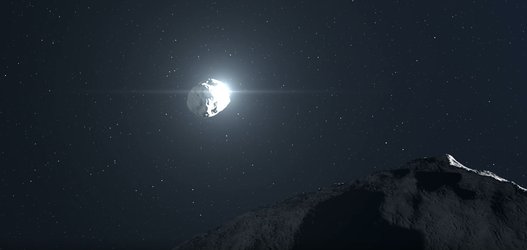Accept all cookies Accept only essential cookies See our Cookie Notice

About ESA
The European Space Agency (ESA) is Europe’s gateway to space. Its mission is to shape the development of Europe’s space capability and ensure that investment in space continues to deliver benefits to the citizens of Europe and the world.
Highlights
ESA - United space in Europe
This is ESA ESA facts Member States & Cooperating States Funding Director General Top management For Member State Delegations European vision European Space Policy ESA & EU Space Councils Responsibility & Sustainability Annual Report Calendar of meetings Corporate newsEstablishments & sites
ESA Headquarters ESA ESTEC ESA ESOC ESA ESRIN ESA EAC ESA ESAC Europe's Spaceport ESA ESEC ESA ECSAT Brussels Office Washington OfficeWorking with ESA
Business with ESA ESA Commercialisation Gateway Law at ESA Careers Cyber resilience at ESA IT at ESA Newsroom Partnerships Merchandising Licence Education Open Space Innovation Platform Integrity and Reporting Administrative Tribunal Health and SafetyMore about ESA
History ESA Historical Archives Exhibitions Publications Art & Culture ESA Merchandise Kids Diversity ESA Brand CentreLatest
Space in Member States
Find out more about space activities in our 23 Member States, and understand how ESA works together with their national agencies, institutions and organisations.
Science & Exploration
Exploring our Solar System and unlocking the secrets of the Universe
Go to topicAstronauts
Missions
Juice Euclid Webb Solar Orbiter BepiColombo Gaia ExoMars Cheops Exoplanet missions More missionsActivities
International Space Station Orion service module Gateway Concordia Caves & Pangaea BenefitsLatest
Space Safety
Protecting life and infrastructure on Earth and in orbit
Go to topicAsteroids
Asteroids and Planetary Defence Asteroid danger explained Flyeye telescope: asteroid detection Hera mission: asteroid deflection Near-Earth Object Coordination CentreSpace junk
About space debris Space debris by the numbers Space Environment Report In space refuelling, refurbishing and removingSafety from space
Clean Space ecodesign Zero Debris Technologies Space for Earth Supporting Sustainable DevelopmentLatest
Applications
Using space to benefit citizens and meet future challenges on Earth
Go to topicObserving the Earth
Observing the Earth Future EO Copernicus Meteorology Space for our climate Satellite missionsCommercialisation
ESA Commercialisation Gateway Open Space Innovation Platform Business Incubation ESA Space SolutionsLatest
Enabling & Support
Making space accessible and developing the technologies for the future
Go to topicBuilding missions
Space Engineering and Technology Test centre Laboratories Concurrent Design Facility Preparing for the future Shaping the Future Discovery and Preparation Advanced Concepts TeamSpace transportation
Space Transportation Ariane Vega Space Rider Future space transportation Boost! Europe's Spaceport Launches from Europe's Spaceport from 2012Latest
Testing camera-based navigation software for asteroid mission
Thank you for liking
You have already liked this page, you can only like it once!
A test campaign took place this autumn at the Madrid headquarters of Spain’s GMV Innovating Solutions company to assess an ESA developed vision-based navigation camera called NPAL (for Navigation for Planetary Approach and Landing) along with a set of navigation algorithms. GMV supplied the 6-degrees-of-freedom robotic arms setup – known as ‘platform-art’, short for Advanced Robotic Testbed for Orbital and Planetary Systems and Operations Testing – which had the camera placed on its tip, to navigate in relation to a model asteroid.
In 2020 ESA’s proposed Asteroid Impact Mission would find its way across deep space using star trackers and radio ranging. Then once it rendezvouses with the two Didymos asteroids, would come the real challenge: navigating around this unprecedented environment to close in on the smaller of the bodies, to perform close-range observations and put down a lander.
By including an actual navigation camera in the loop, the testing team was able to maximise the realism and fidelity of their simulation. The camera itself is fully equipped with a detector that can acquire the images, a ‘frame store’ for their intermediate storage and an image processing chip to perform the feature tracking, plus connection interface to AIM’s guidance and navigation computer.
The NPAL navigation camera takes the images to allow the image processing algorithms to first select landmark ‘feature points’ within its field of view and then to follow them from frame to frame. The changing tracks of the various feature points over time (shown in purple in the video) are checked against the onward and rotational motion of the spacecraft to determine its position and orientation relative to the asteroid.
-
CREDIT
ESA/GMV -
LICENCE
ESA Standard Licence
-
Music Clip
-
-
-
-
-

Preparing AIM navigation camera test

DART impacting asteroid

Robotic arm testing AIM mission's camera

AIM’s eye view of asteroids















 Germany
Germany
 Austria
Austria
 Belgium
Belgium
 Denmark
Denmark
 Spain
Spain
 Estonia
Estonia
 Finland
Finland
 France
France
 Greece
Greece
 Hungary
Hungary
 Ireland
Ireland
 Italy
Italy
 Luxembourg
Luxembourg
 Norway
Norway
 The Netherlands
The Netherlands
 Poland
Poland
 Portugal
Portugal
 Czechia
Czechia
 Romania
Romania
 United Kingdom
United Kingdom
 Slovenia
Slovenia
 Sweden
Sweden
 Switzerland
Switzerland


























